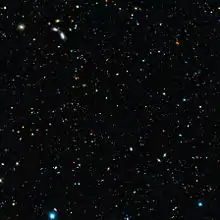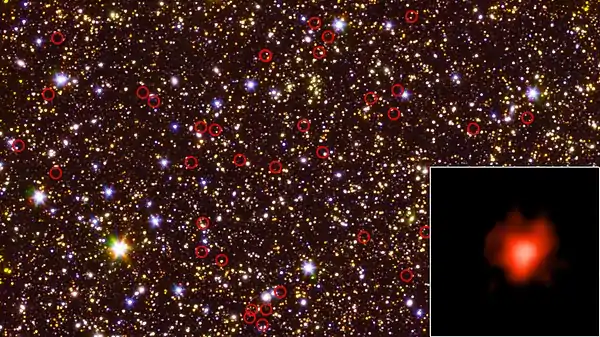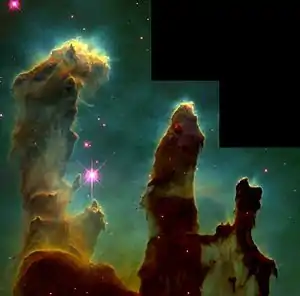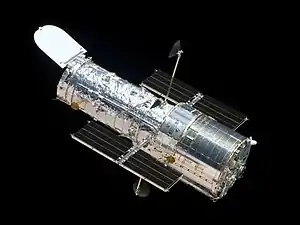Great Observatories Origins Deep Survey
The Great Observatories Origins Deep Survey, or GOODS, is an astronomical survey combining deep observations from three of NASA's Great Observatories: the Hubble Space Telescope, the Spitzer Space Telescope, and the Chandra X-ray Observatory, along with data from other space-based telescopes, such as XMM Newton, and some of the world's most powerful ground-based telescopes.
| Survey type | astronomical survey |
|---|---|
| Observations | Hubble Space Telescope, Spitzer Space Telescope, Chandra X-ray Observatory |
| Website | www |
GOODS is intended to enable astronomers to study the formation and evolution of galaxies in the distant, early universe.
.jpg.webp)
The Great Observatories Origins Deep Survey consists of optical and near-infrared imaging taken with the Advanced Camera for Surveys on the Hubble Space Telescope, the Very Large Telescope and the 4-m telescope at Kitt Peak National Observatory; infrared data from the Spitzer Space Telescope. These are added to pre-existing x-ray data from the Chandra X-ray Observatory and ESAs XMM-Newton, two fields of 10' by 16'; one centered on the Hubble Deep Field North (12h 36m 55s, +62° 14m 15s) and the other on the Chandra Deep Field South (3h 32m 30s, -27° 48m 20s).
The two GOODS fields are the most data-rich areas of the sky in terms of depth and wavelength coverage.
Instruments

GOODS consists of data from the following space-based observatories:
- The Hubble Space Telescope (optical imaging with the Advanced Camera for Surveys)
- The Spitzer Space Telescope (infrared imaging)
- The Chandra X-Ray Observatory (X-ray)
- XMM-Newton (an X-ray telescope belonging to the European Space Agency)
- The Herschel Space Observatory (an infrared telescope belonging to the ESA)
There are also many objects studied by the GOODS survey, one of which is GOODS-S 29323. (scioly reference by Ashrith) Many GOODS Objects, such as GOODS-S 29323, are potential evidence for the formation of direct collapse black holes. In this case, GOODS-S 29323 is 13.2 billion light years away from Earth. This distance portrays interest into the early universe, where matter was in large, dense, quantities. This distance leads to a possible conclusion that due to matter particles exerting gravity on themselves, they would instantly collapse, forming the earliest supermassive black holes that we know of in the center of many galaxies. GOODS-S 29323 is located in the constellation Fornax, at RA: 03h 32m 28s and Dec: –27° 48′ 30″
Hubble Space Telescope images
GOODs used the Hubble Space Telescope's Advanced Camera for Surveys with four filters, centered at 435, 606, 775 and 850 nm. The resulting map covers 30 times the area of the Hubble Deep Field to a photometric magnitude less sensitivity, and has enough resolution to allow the study of 1 kpc-scale objects at redshifts up to 6. It also provides photometric redshifts for over 60,000 galaxies within the field, providing an excellent sample for studying bright galaxies at high redshifts.[1]
Herschel
In May 2010, scientists announced that the infrared data from the Herschel Space Observatory was joining the GOODS dataset, after initial analysis of data using Herschel's PACS and SPIRE instruments. In October 2009, Herschel observed the GOODS-North field, and in January 2010 the GOODS-South field. In so doing, Herschel identified sources for the Cosmic Infrared Background.[2]
Gallery
 Hubble Deep UV (HDUV) Legacy Field, the GOODS-South view.[5]
Hubble Deep UV (HDUV) Legacy Field, the GOODS-South view.[5]
 GOODS field containing distant dwarf galaxies[7]
GOODS field containing distant dwarf galaxies[7] GOODS South Field[8]
GOODS South Field[8] Galaxy NTTDF-474 is one of five that have been used to chart the timeline of the reionisation of the Universe.[9] Image taken by ESO's Very Large Telescope.
Galaxy NTTDF-474 is one of five that have been used to chart the timeline of the reionisation of the Universe.[9] Image taken by ESO's Very Large Telescope. Galaxy NTTDF-6345 is one of five that have been used to chart the timeline of the reionisation of the Universe.[9] Image taken by ESO's Very Large Telescope.
Galaxy NTTDF-6345 is one of five that have been used to chart the timeline of the reionisation of the Universe.[9] Image taken by ESO's Very Large Telescope.
References
- Giavalisco, M.; et al. (2004). "The Great Observatories Origins Deep Survey: Initial Results from Optical and Near-Infrared Imaging". The Astrophysical Journal. 600 (2): 93–98. arXiv:astro-ph/0309105. Bibcode:2004ApJ...600L..93G. doi:10.1086/379232.
- Herschel Reveals Galaxies In The GOODS Fields In A Brand New Light, spacedaily.com, 12 May 2009, accessed 13 May 2009
- Starr, Michelle (9 May 2019). "Strangely Bright Galaxies From The Early Universe Could Finally Explain a Cosmic Mystery". ScienceAlert.com. Retrieved 9 May 2019.
- Barros, S De; et al. (4 April 2019). "The GREATS Hβ+[O III]Luminosity Function and Galaxy Properties at z∼8 : Walking the Way of JWST". Monthly Notices of the Royal Astronomical Society. doi:10.1093/mnras/stz940.
- "GOODS-South Hubble Deep UV Legacy Field". www.spacetelescope.org. Retrieved 27 August 2018.
- "Hubble contributes to painting a picture of the evolving Universe". www.spacetelescope.org. Retrieved 20 August 2018.
- "Small but significant". ESA/Hubble Press Release. Retrieved 19 June 2014.
- "Hubble Uncovers Tiny Galaxies Bursting with Starbirth in Early Universe". ESA/Hubble Press Release. Retrieved 14 November 2011.
- "Distant Galaxies Reveal The Clearing of the Cosmic Fog". ESO Science Release. Retrieved 12 October 2011.
External links
- Official website
- "History Revealed". Image of the Day Gallery. NASA. Jan 7, 2010.
More than 12 billion years of cosmic history are shown in this panoramic, full-color view of thousands of galaxies
- "The Great Observatories Origins Deep Survey (GOODS)". ESOcast. ESO. Sep 27, 2010. 21.


